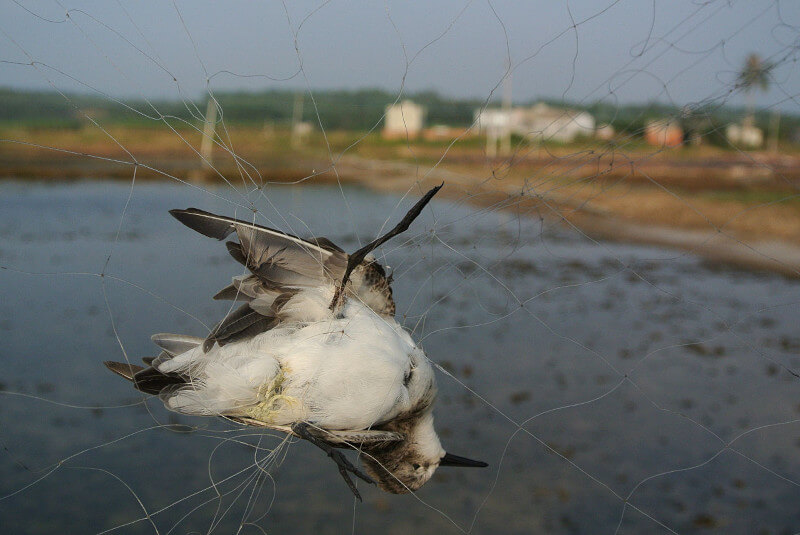
©Jonathan Martinez
The illegal hunting, taking and trade of migratory birds is a serious threat to species across the EAAF and has been linked to declines in some populations, including several threatened species. In many parts of the Flyway, migratory and non-migratory birds are protected under national or sub-national legislation, however, accidental by-catch, and the deliberate targeting of birds is still a major concern and may be a key driver of decline of populations in some species.
With that in mind, in 2017, the Conference of the Parties to the Convention on the Conservation of Migratory Species of Wild Animals (CMS) agreed to establish an Intergovernmental Task Force on Illegal Hunting, Taking and Trade of Migratory Birds in the East Asian-Australasian Flyway (ITTEA), with its Terms of Reference calling for collaboration with the EAAFP. In the following year, at the EAAFP MOP10, Partners agreed to establish a Task Force to address Illegal Hunting, Taking and Trade of Migratory Waterbirds in the EAAF, noting that this task force only covered migratory waterbird taxa identified by the EAAFP. The decision at MOP10 mandated the task force to explore with CMS and other frameworks to extend the scope to other migratory bird species and geographic regions, particularly noting that cooperation with CMS ITTEA would be valuable, as the ITTEA covers a wider variety of taxonomic groups of birds which are currently outside of the scope of the EAAFP. To foster greater collaboration across the Flyway, invitations to join the ITTEA were issued to all EAAF Partners in 2022 to address the issues of illegal hunting, taking and trade of migratory birds.
At the upcoming EAAFP MOP11 in 2023, one of the key priorities will be to convene a joint meeting of the EAAF Task Force and the ITTEA. The aim of this meeting will be to exchange information relating to illegal hunting, taking and trade of migratory birds within the Flyway, discuss priorities for further investigation and collaboration, and develop a joint program of work between the two task forces to be implemented between MOP11 and MOP12. It is important to note that countries do not need to be a Party of CMS to be a member of the ITTEA, and it is envisioned that this task force will also include relevant interested organisations and experts from across the Flyway.
Across the Flyway, several studies are currently underway assessing hunting pressure on migratory waterbirds. In the northern part of the Flyway, Birds Russia are evaluating the hunting pressure on Numenius species and other shorebirds in the Russian Far East. With the support of a EAAFP Small Grant, and funds from the Government of Australia through CMS, research began in Kamchatka in 2019 and continued in Sakhalin Island in 2020. In 2021, two additional regions of the Russian Far East were surveyed — Khabarovskiy Krai and Amur Oblast. Early results show that large number of birds being taken annually, including the globally Endangered Far Eastern Curlew.
In Southeast Asia, Birdlife International worked closely with local stakeholders, NGOs, and universities to assess hunting, taking, and trade of migratory birds from 2019 to 2021. This study involved an academic review of literature on both legal and illegal bird hunting in the region, reviewing the national legal frameworks and legislations relevant to wildlife hunting, and an assessment of bird hunting and trade based on interviews and market surveys in cities and rural areas. The study focused on ten countries in South and Southeast Asia: Bangladesh, Cambodia, Indonesia, Lao PDR, Malaysia, Myanmar, Philippines, Vietnam, Timor Leste and Thailand. A synopsis of the work in mainland Southeast Asia has already been published as a peer-reviewed publication in early 2022 (Yong et al. 2022), and a parallel piece on insular southeast Asia is in preparation. The full report is expected to be released soon and it is expected to outline hunting pressures within each country and the species affected. Additionally, the report will also make recommendations and priority actions required at the local, regional, and landscape scales in order to reduce the impact of bird hunting, taking, and trade of wild populations of migratory waterbirds in the Flyway and beyond.
More information and updates on the EAAF task force can be found on the EAAFP website here, and more information on the ITTEA will be available on the CMS website soon.
Article prepared by EAAFP Task Force on Illegal Hunting, Taking and Trade of Migratory Waterbirds
Read the Paper: Yong, D. L., Jain, A., Chowdhury, S. U., Denstedt, E., Khammavong, K., Milavong, P., Aung, T. D. W., Aung, E. T., Jearwattanakanok, A., Limparungpatthanakij, W., Angkaew, R., Sinhaseni, K., Le, T. T., Nguyen, H. B., Tang, P., Taing, P., Jones, V. R., & Vorsak, B. (2022). The specter of empty countrysides and wetlands—Impact of hunting take on birds in Indo-Burma. Conservation Science and Practice, 4(5), e212668. https://doi.org/10.1111/csp2.12668




